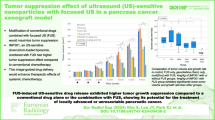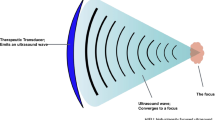Abstract
Objectives
This study was designed to investigate whether focused ultrasound (FUS) treatment with a higher mechanical index (MI) can enhance the effects of combined chemotherapy more than with a lower MI, and to evaluate the feasibility of the chemotherapy combined with FUS at a higher MI as an alternative treatment protocol.
Methods
Mice in the first study were divided into six groups: control, chemotherapy only (GEM), two groups treated with FUS only at two different MIs, and two groups treated with chemotherapy and FUS (GEM + FUS). Mice were treated with a single-session treatment; one session consisted of three weekly treatments and 1 week of follow-up monitoring. In the second study, mice were assigned to two groups (GEM, GEM + FUS) and treated with four treatment sessions.
Results
In the single-session treatment, tumor growth was most effectively suppressed in GEM + FUS group with a higher MI. Tumor growth rate was significantly lower in GEM + FUS group than in GEM group for multiple-session treatment. Specifically, three of ten mice in GEM + FUS group showed complete remission.
Conclusions
This study demonstrated that FUS at a higher MI can enhance chemotherapy outcomes more than at a lower MI and demonstrated the potential of FUS in combination with chemotherapy as a new cancer treatment protocol.
Key points
• Combined treatment of chemotherapy and focused ultrasound can effectively suppress tumor growth.
• For the focused ultrasound treatment conditions used in this study, focused ultrasound with relatively higher mechanical index shows more enhanced therapeutic outcomes than with the lower mechanical index.
• Combination therapy shows the possibility as a new cancer treatment protocol.






Similar content being viewed by others
Abbreviations
- BBB:
-
blood–brain barrier
- CR:
-
complete response
- FUS:
-
focused ultrasound
- GEM:
-
gemcitabine
- H&E:
-
haematoxylin and eosin
- IP:
-
intraperitoneal
- MI:
-
mechanical index
- USgFUS:
-
ultrasound image-guided focused ultrasound
References
American Cancer Society (2011) Global cancer facts & figures, 2nd edn. American Cancer Society, Atlanta. https://www.cancer.org/content/dam/cancer-org/research/cancer-facts-and-statistics/global-cancer-facts-and-figures/global-cancer-facts-and-figures-2nd-edition.pdf. Accessed 12 Jun 2017
Ferlay J SI, Ervik M, Dikshit R, Eser S, Mathers C, Rebelo M, Parkin DM, Forman D, Bray F (2013) GLOBOCAN 2012 v1.0, cancer incidence and mortality worldwide. IARC CancerBase
The Surveillance, Epidemiology, and End Results (SEER) Program of the National Cancer Institute. SEER cancer facts: pancreas cancer. https://seer.cancer.gov/statfacts/html/pancreas.html. Accessed 22 Nov 2017
Kamisawa T, Wood LD, Itoi T, Takaori K (2016) Pancreatic cancer. Lancet 388:73–85
Amrutkar M, Gladhaug IP (2017) Pancreatic cancer chemoresistance to gemcitabine. Cancers 9:–157
de Senneville BD, Moonen C, Ries M (2016) MRI-guided HIFU methods for the ablation of liver and renal cancers. Adv Exp Med Biol 880:43–63
Peek MC, Ahmed M, Scudder J, Baker R, Pinder SE, Douek M (2016) High intensity focused ultrasound in the treatment of breast fibroadenomata: results of the HIFU-F trial. Int J Hyperthermia 32:881–888
Quinn SD, Gedroyc WM (2015) Thermal ablative treatment of uterine fibroids. Int J Hyperthermia 31:272–279
Zhao WP, Han ZY, Zhang J, Yu XL, Cheng ZG, Zhou X et al (2016) Early experience: high-intensity focused ultrasound treatment for intra-abdominal aggressive fibromatosis of failure in surgery. Br J Radiol 89:20151026
Hersh DS, Kim AJ, Winkles JA, Eisenberg HM, Woodworth GF, Frenkel V (2016) Emerging applications of therapeutic ultrasound in neuro-oncology: moving beyond tumor ablation. Neurosurgery 79:643–654
Lin Q, Mao KL, Tian FR, Yang JJ, Chen PP, Xu J et al (2016) Brain tumor-targeted delivery and therapy by focused ultrasound introduced doxorubicin-loaded cationic liposomes. Cancer Chemother Pharmacol 77:269–280
Park EJ, Zhang YZ, Vykhodtseva N, McDannold N (2012) Ultrasound-mediated blood-brain/blood-tumor barrier disruption improves outcomes with trastuzumab in a breast cancer brain metastasis model. J Control Release 163:277-284
Dalecki D (2004) Mechanical bioeffects of ultrasound. Ann Rev Biomed Eng 6:229-248
American Institute of Ultrasound in Medicine (2000) Section 6–mechanical bioeffects in the presence of gas-carrier ultrasound contrast agents. J Ultrasound Med 19:54–68
American Institute of Ultrasound in Medicine (2000) Section 5–nonthermal bioeffects in the absence of well-defined gas bodies. J Ultrasound Med 19, 54-68
Miller DL, Smith NB, Bailey MR, Czarnota GJ, Hynynen K, Makin IR (2012) Overview of therapeutic ultrasound applications and safety considerations. J Ultrasound Med 31:623–634
O'Brien WD Jr (2007) Ultrasound-biophysics mechanisms. Prog Biophys Mol Biol 93:212–255
Humphrey VF (2007) Ultrasound and matter–physical interactions. Prog Biophys Mol Biol 93:195–211
Hoogenboom M, Eikelenboom D, den Brok MH, Heerschap A, Futterer JJ, Adema GJ (2015) Mechanical high-intensity focused ultrasound destruction of soft tissue: working mechanisms and physiologic effects. Ultrasound Med Biol 41:1500–1517
Khokhlova VA, Fowlkes JB, Roberts WW, Schade GR, Xu Z, Khokhlova TD et al (2015) Histotripsy methods in mechanical disintegration of tissue: towards clinical applications. Int J Hyperthermia 31:145–162
Cao Y, Gao M, Chen C, Fan A, Zhang J, Kong D et al (2015) Triggered-release polymeric conjugate micelles for on-demand intracellular drug delivery. Nanotechnology 26:115101
Karavelidis V, Bikiaris D, Avgoustakis K (2015) New thermosensitive nanoparticles prepared by biocompatible pegylated aliphatic polyester block copolymers for local cancer treatment. J Pharm Pharmacol 67:215–230
Ta T, Bartolak-Suki E, Park EJ, Karrobi K, McDannold NJ, Porter TM (2014) Localized delivery of doxorubicin in vivo from polymer-modified thermosensitive liposomes with MR-guided focused ultrasound-mediated heating. J Control Release 194:71-81
Wang A, Gao H, Sun Y, Sun YL, Yang YW, Wu G et al (2013) Temperature- and pH-responsive nanoparticles of biocompatible polyurethanes for doxorubicin delivery. Int J Pharm 441:30–39
Yu D, Li W, Zhang Y, Zhang B (2016) Anti-tumor efficiency of paclitaxel and DNA when co-delivered by pH responsive ligand modified nanocarriers for breast cancer treatment. Biomed Pharmacother 83:1428–1435
Sanson C, Diou O, Thevenot J, Ibarboure E, Soum A, Brulet A et al (2011) Doxorubicin loaded magnetic polymersomes: theranostic nanocarriers for MR imaging and magneto-chemotherapy. ACS Nano 5:1122–1140
Helfield B, Chen X, Watkins SC, Villanueva FS (2016) Biophysical insight into mechanisms of sonoporation. Proc Natl Acad Sci U S A 113:9983–9988
Shi D, Guo L, Duan S, Shang M, Meng D, Cheng L et al (2016) Influence of tumor cell lines derived from different tissue on sonoporation efficiency under ultrasound microbubble treatment. Ultrason Sonochem. https://doi.org/10.1016/j.ultsonch.2016.08.022
ter Haar G (2007) Therapeutic applications of ultrasound. Prog Biophys Mol Biol 93:111–129
Kotopoulis Kotopoulis S, Delalande A, Popa M, Mamaeva V, Dimcevski G, Gilja OH et al (2014) Sonoporation-enhanced chemotherapy significantly reduces primary tumor burden in an orthotopic pancreatic cancer xenograft. Mol Imaging Biol 16:53–62
Yu MH, Lee JY, Kim HR, Kim BR, Park EJ, Kim HS et al (2016) Therapeutic effects of microbubbles added to combined high-intensity focused ultrasound and chemotherapy in a pancreatic cancer xenograft model. Korean J Radiol 17:779–788
Kotopoulis S, Stigen E, Popa M, Safont MM, Healey A, Kvale S et al (2017) Sonoporation with Acoustic Cluster Therapy (ACT®) induces transient tumor volume reduction in a subcutaneous xenograft model of pancreatic ductal adenocarcinoma. J Control Release 245:70–80
Lee ES, Lee JY, Kim H, Choi Y, Park J, Han JK et al (2013) Pulsed high-intensity focused ultrasound enhances apoptosis of pancreatic cancer xenograft with gemcitabine. Ultrasound Med Biol 39:1991–2000
ab Ithel Davies I, Gavrilov LR, Tsirulnikov EM (1996) Application of focused ultrasound for research on pain. Pain 67:17–27
Yudina A, Moonen C (2012) Ultrasound-induced cell permeabilisation and hyperthermia: strategies for local delivery of compounds with intracellular mode of action. Int J Hyperthermia 28:311–319
Park J, Zhang Y, Vykhodtseva N, Akula JD, McDannold NJ (2012) Targeted and reversible blood-retinal barrier disruption via focused ultrasound and microbubbles. PloS one 7:e42754
Aryal M, Park J, Vykhodtseva N, Zhang YZ, McDannold N (2015) Enhancement in blood-tumor barrier permeability and delivery of liposomal doxorubicin using focused ultrasound and microbubbles: evaluation during tumor progression in a rat glioma model. Phys Med Biol 60:2511–2527
Okunaga S, Takasu A, Meshii N, Imai T, Hamada M, Iwai S et al (2015) Ultrasound as a method to enhance antitumor ability of oncolytic herpes simplex virus for head and neck cancer. Cancer Gene Ther 22:163–168
Qin J, Wang TY, Willmann JK (2016) Sonoporation: applications for cancer therapy. Adv Exp Med Biol 880:263–291
Jin Z, Choi Y, Ko SY, Park JO, Park S (2017) Experimental and simulation studies on focused ultrasound triggered drug delivery. Biotechnol Appl Biochem 64:134–142
Park EJ, Werner J, Smith NB (2007) Ultrasound mediated transdermal insulin delivery in pigs using a lightweight transducer. Pharm Res 24:1396–1401
Chae SY, Kim YS, Park MJ, Yang J, Park H, Namgung MS et al (2014) High-intensity focused ultrasound-induced, localized mild hyperthermia to enhance anti-cancer efficacy of systemic doxorubicin: an experimental study. Ultrasound Med Biol 40:1554–1563
Ventre DM, Koppes AN (2016) The body acoustic: ultrasonic neuromodulation for translational medicine. Cells Tissues Organs 202:23–41
Cohen-Inbar O, Xu Z, Sheehan JP (2016) Focused ultrasound-aided immunomodulation in glioblastoma multiforme: a therapeutic concept. J Ther Ultrasound 4:2
Focused Ultrasound Foundation. Disease and conditions. https://www.fusfoundation.org/diseases-and-conditions-all/overview. Accessed 12 Jun 2017
Coussios CC, Farny CH, Haar GT, Roy RA (2007) Role of acoustic cavitation in the delivery and monitoring of cancer treatment by high-intensity focused ultrasound (HIFU). Int J Hyperthermia 23:105–120
Kopechek JA, Park EJ, Zhang YZ, Vykhodtseva NI, Mcdannold NJ, Porter TM (2014) Cavitation-enhanced MR-guided focused ultrasound ablation of rabbit tumors in vivo using phase shift nanoemulsions. Phys Med Biol 59:3465–3481
Lammertink BH, Bos C, van der Wurff-Jacobs KM, Storm G, Moonen CT, Deckers R (2016) Increase of intracellular cisplatin levels and radiosensitization by ultrasound in combination with microbubbles. J Control Release 238:157–165
Tachibana K, Endo H, Feril LB, Nejad SM, Takahashi H, Narihira K et al (2015) Enhanced mechanical damage to in vitro cancer cells by high-intensity-focused ultrasound in the presence of microbubbles and titanium dioxide. J Med Ultrason (2001) 42:449–455
Liu HL, Fan CH, Ting CY, Yeh CK (2014) Combining microbubbles and ultrasound for drug delivery to brain tumors: current progress and overview. Theranostics 4:432–444
Funding
This study has received funding by the National Research Foundation of Korea, which is funded by the Ministry of Science, ICT & Future Planning (2012R1A1A1010930).
Author information
Authors and Affiliations
Corresponding author
Ethics declarations
Guarantor
The scientific guarantor of this publication is Jae Young Lee.
Conflict of interest
The authors of this manuscript declare no relationships with any companies whose products or services may be related to the subject matter of the article.
Statistics and biometry
No complex statistical methods were necessary for this paper.
Basic statistical methods were used by the authors who are well trained in clinical statistics.
Informed consent
This study was performed on animal models.
Ethical approval
Approval from the institutional animal care committee of Seoul National University Hospital was obtained.
Methodology
• prospective
• experimental
• performed at one institution.
Rights and permissions
About this article
Cite this article
Park, EJ., Ahn, Y.D. & Lee, J.Y. In vivo study of enhanced chemotherapy combined with ultrasound image-guided focused ultrasound (USgFUS) treatment for pancreatic cancer in a xenograft mouse model. Eur Radiol 28, 3710–3718 (2018). https://doi.org/10.1007/s00330-018-5355-9
Received:
Revised:
Accepted:
Published:
Issue Date:
DOI: https://doi.org/10.1007/s00330-018-5355-9




